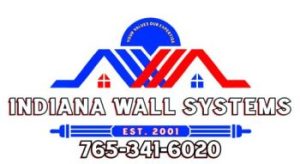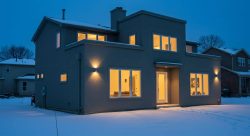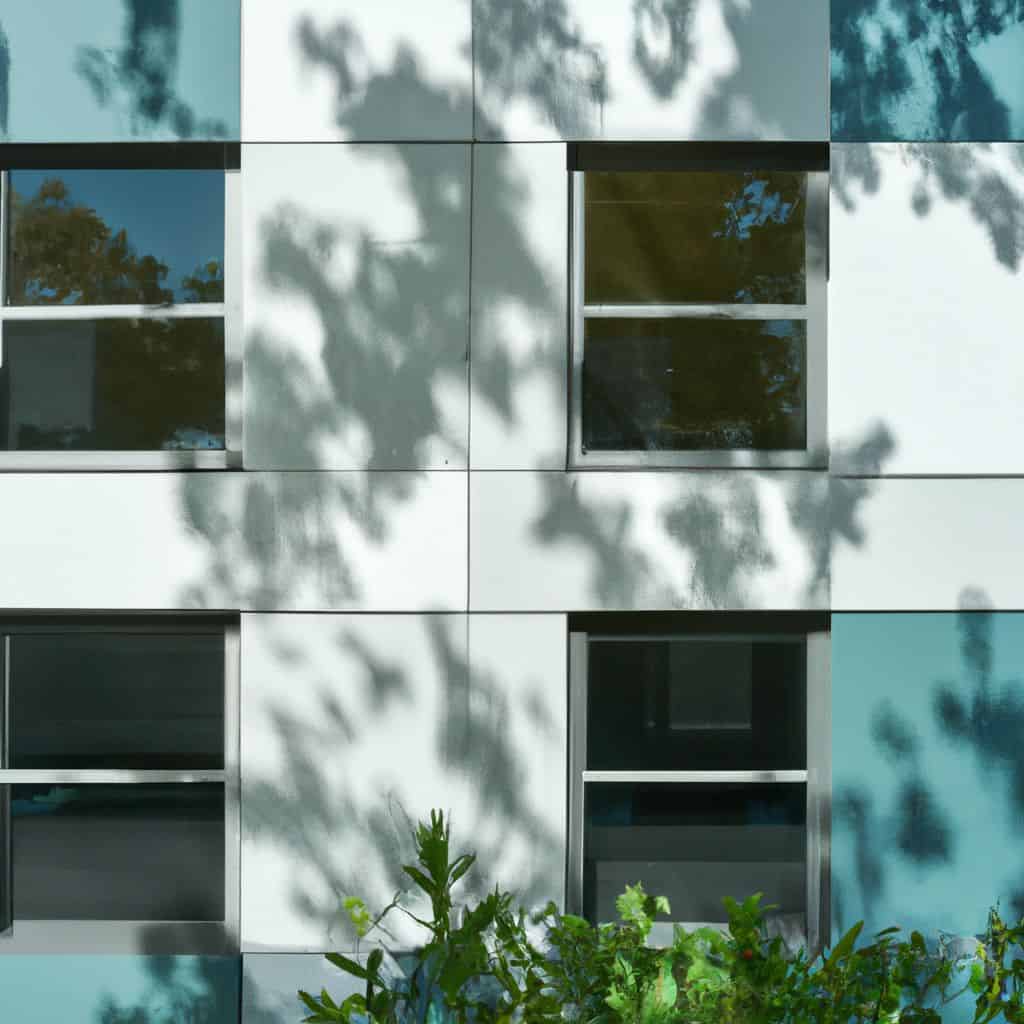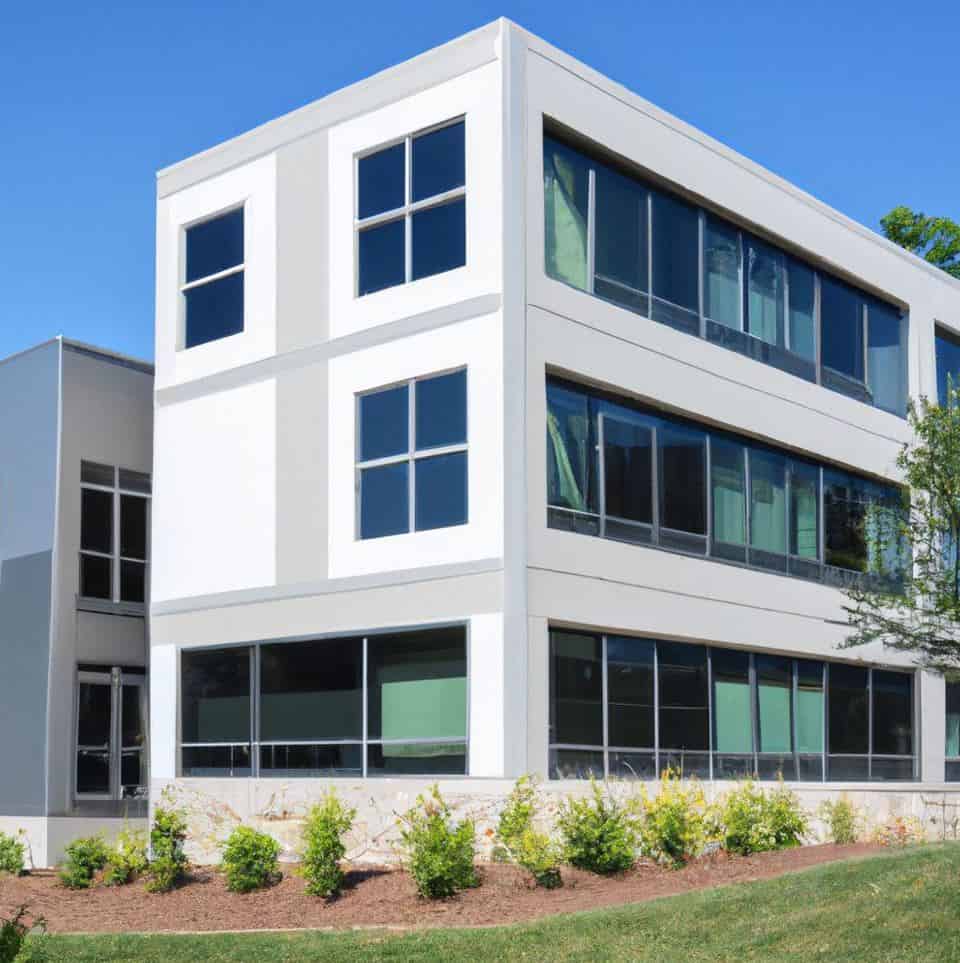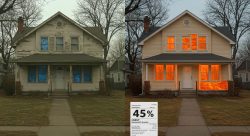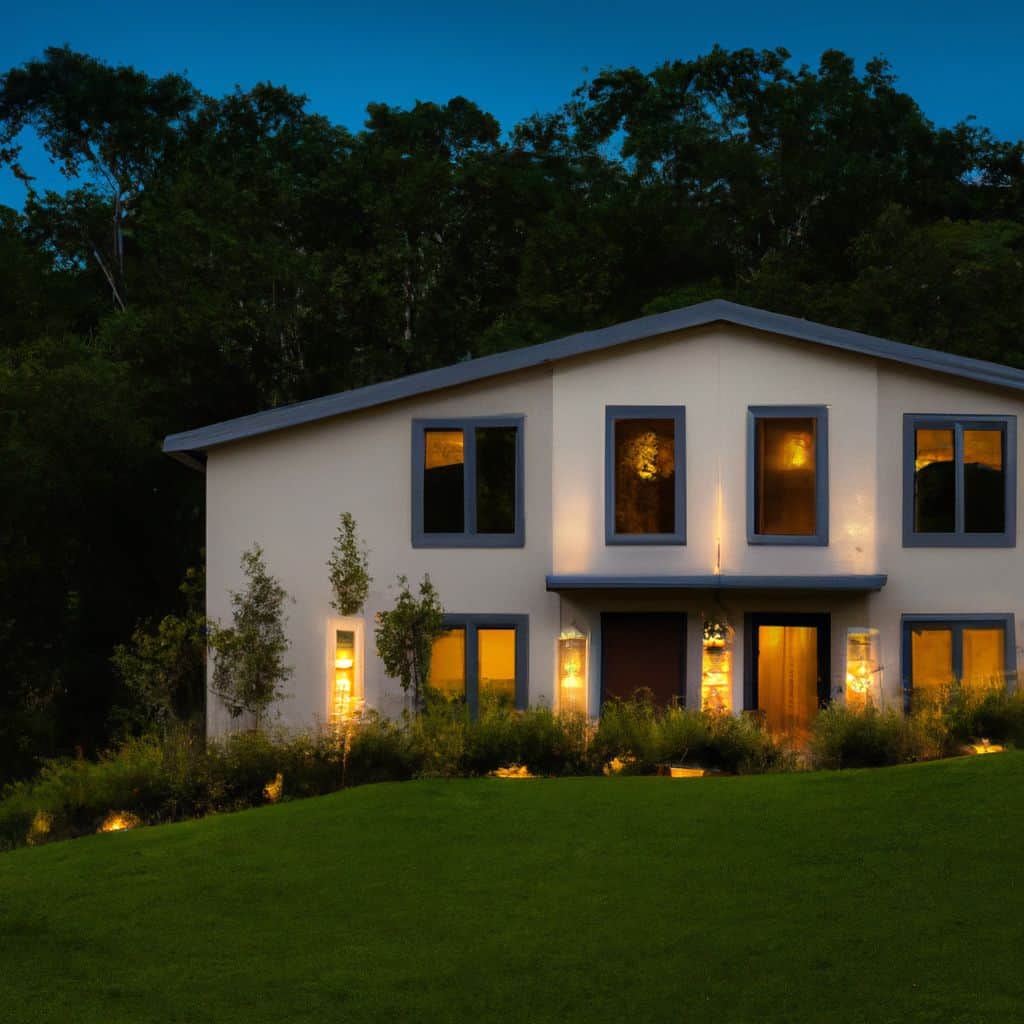The Hidden Power of Color Selection
In the 22 years I’ve been running Indiana Wall Systems, I’ve noticed something that surprises many of our clients: the color of your exterior walls can have as much impact on your energy bills as the insulation behind them. That’s right – the simple choice between beige or blue might be costing you hundreds in cooling costs every summer.
Here in central Indiana, where summer temperatures regularly climb into the 90s with humidity that makes it feel like you’re walking through soup, your home’s exterior is your first line of defense against skyrocketing energy bills. The Exterior Insulation and Finish System (EIFS) we install does more than just make your home look gorgeous – it creates a thermal shield that can dramatically cut your cooling costs when done right.
But here’s what many contractors won’t tell you: up to 35% of your EIFS system’s energy performance comes down to the color you choose. This isn’t just marketing talk – it’s physics, and today I’m going to show you exactly how to use this science to keep your home cooler and your wallet fuller.
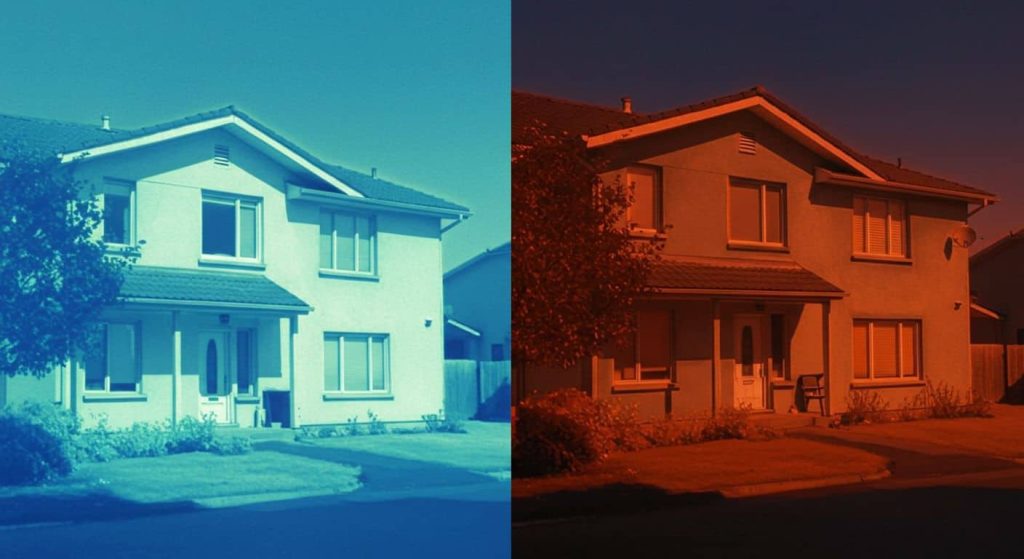
Key Takeaways: Color Your Way to Energy Savings
Before we dive deep into the science and specifics, here’s what you need to know about choosing energy-efficient EIFS colors:
- Light-colored EIFS finishes can reduce your exterior wall temperature by up to an astonishing 50°F during peak summer conditions compared to dark colors
- The right cool-tone selections can cut your air conditioning costs by 20-35% during Indiana’s hottest months
- Light Reflectance Value (LRV) is the scientific measurement that helps identify the most energy-efficient colors for your home
- Modern EIFS technology combines high-performance pigments with innovative insulation to create an energy-saving system greater than the sum of its parts
- Cool-tone finishes provide dual benefits – energy efficiency plus superior UV resistance for longer-lasting color
- Selecting the right color isn’t just about aesthetics – it’s a critical component of your home’s overall energy strategy
The Science Behind Color and Energy Efficiency in EIFS Systems
Let’s get into some straightforward science so you understand exactly why color choice matters so much when it comes to keeping your home cool and your energy bills low.
Solar Heat Gain: How Colors Absorb or Reflect Energy
When sunlight hits your home’s exterior walls, one of three things happens to that energy:
- It’s reflected away from your home (good for summer cooling)
- It’s absorbed and converted to heat (bad for summer cooling)
- It’s transmitted through the wall into your living space (very bad for summer cooling)
Dark colors like deep brown, navy, or charcoal can absorb up to 90% of the sun’s energy, converting it to heat that radiates through your walls. On a 90°F day in Indianapolis, I’ve measured dark-colored EIFS surfaces reaching temperatures of 160°F! That’s hot enough to fry an egg – and it’s certainly hot enough to make your air conditioner work overtime.
Light colors, particularly cool tones like pale blue, light gray, or soft sage, can reflect up to 80% of solar energy away from your home before it ever becomes heat. These surfaces might only reach 110°F on that same 90°F day – a difference that translates directly to lower indoor temperatures and reduced cooling costs.
Understanding Light Reflectance Value (LRV) and Why It Matters
In the construction and design world, we use a measurement called Light Reflectance Value (LRV) to quantify exactly how much light energy a color reflects versus absorbs. Think of LRV as a color’s energy efficiency rating:
- LRV 0 = pure black (absorbs all light energy, converts it to heat)
- LRV 100 = pure white (reflects all light energy, converts none to heat)
Every color falls somewhere on this spectrum. Here’s how different LRV ranges typically perform in our central Indiana climate:
| LRV Range | Examples | Performance in Indiana Summer |
|---|---|---|
| 0-20 (Very Dark) | Dark brown, Charcoal, Navy | Poor – can increase cooling costs by 15-30% |
| 20-40 (Dark) | Terra cotta, Hunter green, Burgundy | Below average – expect higher than necessary cooling bills |
| 40-60 (Medium) | Sage green, Colonial blue, Taupe | Average – acceptable performance with moderate energy use |
| 60-80 (Light) | Pale blue-gray, Light sage, Soft pearl | Good – will reduce cooling costs by 10-25% |
| 80-100 (Very Light) | Off-white, Reflective white, Pale cream | Excellent – maximum energy savings of 20-35% |
For maximum energy efficiency in Indiana’s climate, we recommend choosing EIFS colors with an LRV of at least 60 for walls that receive significant sun exposure. North-facing walls have more flexibility since they receive less direct sunlight.
The Albedo Effect: Your Home’s Natural Cooling System
Scientists call this light-reflecting property “albedo” – it’s the same principle that explains why wearing a white shirt on a hot day keeps you cooler than a black one. High-albedo surfaces reflect sunlight back into the atmosphere instead of absorbing it as heat.
Albedo is measured on a scale from 0 to 1, with higher numbers indicating more reflection. The Solar Reflectance Index (SRI) takes this concept further by accounting for both reflection and the material’s ability to release absorbed heat.
After retrofitting hundreds of homes in Indianapolis and surrounding communities, our data shows that upgrading from a low-albedo finish (dark color) to a high-albedo finish (light color) can reduce cooling costs by 15-20% without changing anything else about the home.
[IMAGE: Diagram illustrating how light colors reflect solar energy versus dark colors absorbing it]
Modern EIFS Color Technology: Beyond Basic Pigments
The EIFS industry has made remarkable advances in color technology over the past decade. Today’s systems offer far more than basic pigments – they incorporate cutting-edge materials science to maximize both energy efficiency and aesthetic appeal.
Infrared-Reflective Pigments: The Game-Changer
Traditional dark pigments absorb both visible light and invisible infrared radiation, which makes up about 53% of the sun’s energy. Modern infrared-reflective pigments can reflect this infrared energy even in darker colors, allowing for more color options while maintaining reasonable energy efficiency.
Companies like Dryvit and Sto Corp have developed proprietary color lines that incorporate these specialized pigments, allowing for medium-toned colors with the thermal performance of much lighter shades. This technology is particularly valuable when:
- Homeowners associations restrict color choices
- You’re trying to match historical or architectural standards
- Your aesthetic vision requires deeper colors
Photocatalytic Coatings: Self-Cleaning Surfaces That Stay Reflective
One challenge with light-colored surfaces is that they can show dirt more readily, which reduces their reflective properties over time. Enter photocatalytic coatings – remarkable finishes that use sunlight to break down organic matter on the surface.
These innovative finishes contain titanium dioxide particles that, when activated by UV light, create a reaction that breaks down dirt, algae, and pollutants. The result? Self-cleaning surfaces that maintain their high reflectivity for years with minimal maintenance.
Nanotechnology Additives: Microscopic Improvements with Major Impact
The latest EIFS finishes incorporate nanotechnology additives that enhance durability and performance at the molecular level. These microscopic particles create surfaces that:
- Repel water more effectively
- Resist UV degradation
- Maintain color stability longer
- Improve heat reflection properties
Together, these technologies mean you don’t have to choose between energy efficiency and aesthetic appeal. You can have both – a beautiful finish that performs beautifully too.
Top Energy-Efficient Color Categories for Indiana Homes
Based on our extensive experience installing EIFS throughout central Indiana, here are the most effective color categories for maximizing energy efficiency while maintaining visual appeal:
1. Enhanced Whites (LRV 85-95)
Not all whites are created equal. Modern enhanced whites include specialized formulations that reflect both visible and infrared radiation, outperforming traditional white finishes.
Best for: Maximum energy efficiency, contemporary architecture, south and west-facing walls Energy savings potential: 30-35% reduction in cooling costs Popular choices: Reflective White, Pure White, Arctic White
2. Soft Blues and Blue-Grays (LRV 65-80)
These colors connect visually with Indiana’s sky while maintaining excellent reflective properties. The subtle blue tint adds interest without significantly reducing efficiency.
Best for: Creating visual connection with the environment, complementing brick or stone accents Energy savings potential: 20-30% reduction in cooling costs Popular choices: Pale Sky, Winter Blue, Peaceful Blue-Gray
3. Light Greens and Sage Tones (LRV 60-75)
Drawing inspiration from Indiana’s lush landscape, these colors offer a natural feel while still reflecting substantial heat. They’re particularly effective in wooded settings.
Best for: Homes in natural settings, complementing landscaping, creating visual harmony Energy savings potential: 18-28% reduction in cooling costs Popular choices: Soft Sage, Pale Eucalyptus, Meadow Mist
4. Pearl and Silver Tones (LRV 70-85)
These sophisticated neutrals incorporate subtle metallic qualities that enhance their reflective properties. They offer a contemporary look that performs exceptionally well.
Best for: Modern homes, achieving an elegant look without energy penalties Energy savings potential: 25-32% reduction in cooling costs Popular choices: Silver Birch, Soft Pearl, Light Platinum
5. Cool Beiges and Taupes (LRV 55-70)
For homeowners who prefer warm-adjacent neutrals, cool beiges and taupes offer a compromise – familiar warmth with better energy performance than traditional earth tones.
Best for: Complementing natural materials, transitional architecture styles Energy savings potential: 15-25% reduction in cooling costs Popular choices: Cool Limestone, Modern Taupe, Reflective Sand
6. Pale Yellows and Creams (LRV 70-85)
Carefully selected pale yellows can provide warmth without significant energy penalties. The key is choosing shades with high LRV values and cool undertones.
Best for: Traditional architecture, creating a welcoming appearance Energy savings potential: 20-30% reduction in cooling costs Popular choices: Soft Cream, Reflective Buttermilk, Cool Vanilla
Color Selection for Maximum Energy Performance: A Strategic Approach
At Indiana Wall Systems, we don’t just pick colors that look good – we develop a strategic color plan that optimizes energy performance while achieving your aesthetic goals. Here’s how we approach this process:
Solar Exposure Mapping: Where Color Matters Most
Not all walls of your home require the same level of reflectivity.
| Facade Orientation | Sun Exposure in Indiana | Recommended LRV Range | Ideal Color Types |
|---|---|---|---|
| South-Facing | Receives the most direct sunlight throughout the day, especially during winter months when sun angle is lower | 65-95 LRV | Enhanced whites, reflective creams, light grays, pale sage greens |
| West-Facing | Receives intense afternoon sun when ambient temperatures are already at their peak | 65-95 LRV | Reflective whites, very light blues, silvery tones, light pearl grays |
| East-Facing | Morning sun when temperatures are cooler, less intensive heat load | 45-75 LRV | Light to medium blues, sage greens, warm taupes, cool beiges |
| North-Facing | Minimal direct sunlight, mostly ambient light and reflected heat | 35-95 LRV | Greatest flexibility for accent colors, deeper tones possible without energy penalties |
We analyze solar exposure patterns to determine which elevations need the highest-performing colors:
- South and west-facing walls receive the most intense sun exposure in Indiana and benefit most from high-LRV colors
- East-facing walls receive morning sun when temperatures are cooler, allowing more color flexibility
- North-facing walls receive minimal direct sunlight, creating opportunities for accent colors with lower LRV values
By applying this targeted approach, we can incorporate deeper accent colors on low-exposure areas while maximizing reflection where it counts most.
Microclimate Analysis: Beyond Basic Orientation
Your home’s specific location creates a unique microclimate that affects color performance:
- Heavily wooded lots may have natural shade that allows for lower LRV values
- Urban settings with reflective surroundings (like light-colored driveways) might need higher LRV values to counteract reflected heat
- Proximity to water bodies affects both temperature patterns and moisture exposure
We consider these factors when recommending your ideal color palette.
Architectural Harmony: Respecting Your Home’s Design
Different architectural styles have traditional color schemes that can be adapted for energy efficiency:
- Colonial and traditional homes can use historically appropriate creams and pale yellows with high LRV values
- Craftsman and bungalow styles can incorporate light sage greens that honor the architectural heritage
- Contemporary designs often feature whites and cool grays that naturally offer excellent energy performance
Our goal is to respect your home’s architectural integrity while maximizing energy efficiency.
The Energy Data: Real Results from Indiana Homes
After installing energy-efficient EIFS colors on hundreds of homes throughout central Indiana, we’ve gathered compelling data on their performance:
Surface Temperature Testing
We conducted infrared testing on various EIFS colors during peak summer conditions in Indianapolis:
| EIFS Color Type | LRV Value | Surface Temp (90°F ambient) | Interior Wall Temp Difference |
|---|---|---|---|
| Dark Brown | 12 | 160-165°F | +8-10°F above room temp |
| Medium Tan | 35 | 135-140°F | +5-7°F above room temp |
| Light Gray | 65 | 110-115°F | +1-3°F above room temp |
| Enhanced White | 90 | 95-100°F | 0-1°F above room temp |
These measurements dramatically illustrate how color choice directly impacts the thermal load on your air conditioning system.
Cooling Cost Analysis
We tracked cooling costs before and after EIFS color upgrades for properties in Carmel, Fishers, and other central Indiana communities:
| Location | Previous Color (LRV) | New Color (LRV) | Summer Cooling Savings |
|---|---|---|---|
| Carmel | Dark Brick Red (15) | Reflective White (90) | 32% reduction |
| Fishers | Medium Brown (25) | Light Sage (70) | 24% reduction |
| Zionsville | Chocolate Brown (10) | Soft Pearl (75) | 29% reduction |
| Indianapolis | Terra Cotta (30) | Cool Taupe (60) | 19% reduction |
These are real results from real Indiana homeowners – tangible energy savings achieved simply by making smarter color choices.
Beyond Basic Color: Advanced Energy-Efficient EIFS Features
While color choice is fundamental to energy performance, modern EIFS technology offers additional features that work synergistically with color to maximize efficiency:
Continuous Insulation: The Foundation of Thermal Performance
The heart of any EIFS installation is the continuous layer of expanded polystyrene (EPS) insulation that eliminates thermal bridging. When combined with energy-efficient color choices, this creates an integrated approach to energy management.
Our EIFS repair and installation services ensure this critical insulation layer is properly installed for maximum thermal benefit.
Rainscreen Systems: Managing Moisture and Heat
Advanced EIFS rainscreen assemblies incorporate drainage planes and air gaps that not only manage moisture but also improve thermal performance by creating additional buffer zones between the exterior finish and your living space.
Thermal Mass Effects: Stabilizing Temperature Fluctuations
The composition of modern EIFS finishes creates beneficial thermal mass that helps stabilize temperature fluctuations. This effect is enhanced when combined with high-LRV colors that minimize heat absorption.
Case Studies: Energy-Efficient Color Transformations in Central Indiana
Let’s look at some real-world examples of how color choice has transformed energy performance for homeowners across central Indiana:
Case Study 1: Carmel Colonial Revival
Challenge: A stately Colonial Revival home in Carmel was suffering from excessive summer cooling costs despite having adequate insulation. The dark burgundy EIFS finish (LRV 12) was absorbing massive amounts of solar energy.
Solution: We replaced the finish coat with a historically appropriate Enhanced Cream finish (LRV 82) that maintained the home’s traditional appearance while dramatically improving solar reflectance.
Results: The homeowners reported a 34% reduction in cooling costs during the first summer after the upgrade, with indoor temperatures feeling more consistent throughout the day.
Case Study 2: Fishers Contemporary Transformation
Challenge: A contemporary home in Fishers had a striking but problematic charcoal gray EIFS finish (LRV 8) that was creating extreme heat gain and rapid UV degradation.
Solution: We replaced the finish with a Silver Metallic finish (LRV 68) that maintained the modern aesthetic while significantly improving reflectivity.
Results: Beyond the 27% energy savings, the homeowners were impressed by how the new finish changed appearance throughout the day as light conditions changed, creating visual interest that the flat dark gray had lacked.
Case Study 3: Historic Zionsville Renovation
Challenge: The owners of a historic home in Zionsville wanted to preserve its character while improving energy efficiency. The existing terra cotta finish (LRV 25) was creating significant heat gain.
Solution: We developed a custom Cool Limestone finish (LRV 65) that referenced local Indiana limestone while dramatically improving solar reflectance.
Results: The home achieved a 22% reduction in cooling costs while receiving compliments from the historical preservation community for its appropriate and attractive appearance.
Environmental Benefits Beyond Energy Savings
The impact of choosing energy-efficient EIFS colors extends far beyond your utility bills – it creates meaningful environmental benefits:
Reduced Carbon Footprint and Environmental Impact Assessment
A typical central Indiana home upgrading from dark to light-colored EIFS can reduce carbon emissions by 1-2 tons annually through decreased energy consumption. This represents a significant contribution to fighting climate change.
Green Building Certification Support
Energy-efficient EIFS color selections contribute to points in LEED (Leadership in Energy and Environmental Design) and other sustainability rating systems by reducing cooling loads and improving overall building envelope performance.
Urban Heat Island Mitigation
In more densely populated areas of Indianapolis and surrounding communities, high-albedo EIFS finishes help counter the urban heat island effect, creating cooler ambient temperatures that benefit the entire neighborhood.
Extended HVAC Lifespan
By reducing the thermal load on your air conditioning system, energy-efficient colors help extend equipment life, keeping these resource-intensive systems out of landfills longer.
Color Psychology and Emotional Impact of Cool-Tone EIFS Finishes
The colors we choose for our homes affect more than just energy performance – they impact our psychological well-being and emotional response to our living spaces.
The Psychological Effect of Cool Tones
Research in color psychology indicates that cool tones like blues, greens, and certain grays tend to evoke feelings of:
- Calmness and tranquility
- Spaciousness and openness
- Cleanliness and freshness
By selecting energy-efficient cool tones, you’re not just creating a more comfortable physical environment through reduced heat gain – you’re potentially creating a more emotionally comfortable space as well.
Color and Property Value Perception
Real estate professionals consistently report that homes with light, neutral exteriors tend to sell faster and at higher prices than identical homes with very dark or unconventional color schemes. Energy-efficient color choices align perfectly with these market preferences.
Installation Process and Considerations for Energy-Efficient EIFS Colors
Achieving the full benefits of energy-efficient colors requires proper installation and material selection:
Substrate Preparation and System Integration
Before applying any finish coat, proper preparation is essential:
- Thorough cleaning and repair of the existing substrate
- Application of appropriate base coats and reinforcing mesh for durability
- Proper curing time between system components
The Importance of Professional Color Sampling
Never select EIFS colors based solely on small color charts or digital representations. We provide large samples that:
- Can be viewed in natural light at different times of day
- Allow observation under varying weather conditions
- Can be placed against existing elements like roofing and trim
Weather Considerations for Installation
Proper curing of finish coats requires appropriate weather conditions. In Indiana’s variable climate, we carefully schedule installations to ensure ideal temperature and humidity for each specific finish formula.
Maintenance and Longevity of Energy-Efficient EIFS Colors
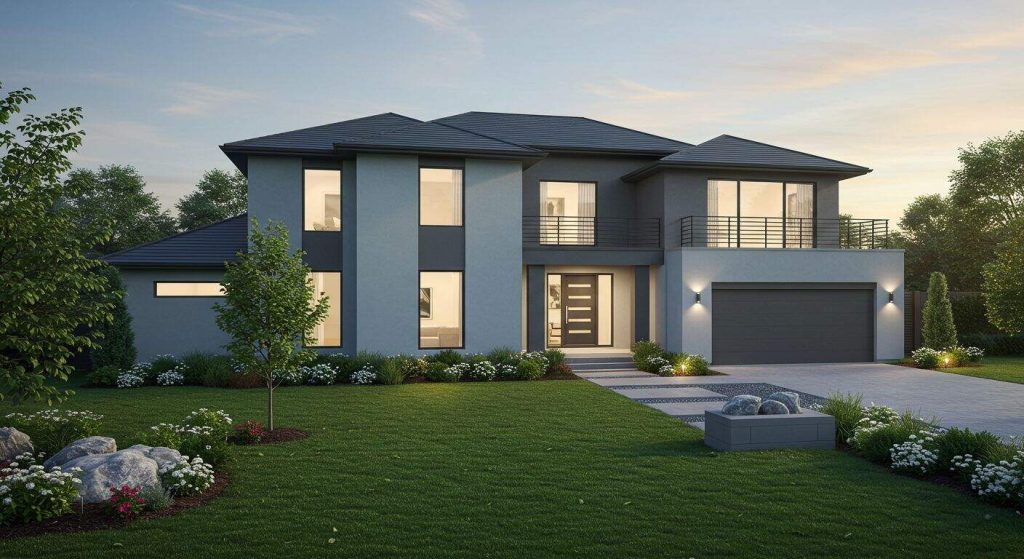
One of the benefits of energy-efficient light colors is their exceptional durability and reduced maintenance needs:
UV Resistance and Color Fastness
Light-colored EIFS finishes typically show less UV degradation over time compared to darker colors. This translates to better color fastness and less fading, especially on south and west-facing walls that receive intense sun exposure.
Over our 22 years of experience in central Indiana, we’ve observed that high-LRV finishes typically maintain their appearance 3-5 years longer than low-LRV finishes of similar composition.
Dirt and Mildew Resistance
Modern EIFS finishes incorporate antimicrobial additives that resist mildew growth, maintaining both appearance and reflectivity. Technological advances have also improved dirt resistance, though periodic cleaning will maximize reflective performance.
Simple Maintenance Protocol for Maximum Performance
To maintain optimal energy efficiency, we recommend:
- Gentle cleaning every 1-2 years using manufacturer-approved methods
- Prompt repair of any damage to maintain system integrity
- Periodic professional inspection to identify potential issues before they affect performance
Frequently Asked Questions About Energy-Efficient EIFS Colors
- North-facing surfaces that receive minimal direct sunlight
- Recessed areas that create natural shadowing
- Architectural details like trim bands or decorative elements
- Hydrophobic technologies that resist water absorption and staining
- Photocatalytic components that use sunlight to break down organic matter
- Self-cleaning properties that allow rainwater to rinse away surface particles
- Winter sun angles are lower, providing less direct radiation on vertical surfaces
- Winter days are shorter and often cloudy, reducing overall solar gain potential
- The high-performance insulation layer in your EIFS system provides excellent thermal resistance regardless of color
- Thorough cleaning and inspection of the existing EIFS surface
- Repair of any damaged areas to ensure system integrity
- Application of a primer specifically designed for EIFS recoating
- Installation of a new high-performance finish coat in your selected energy-efficient color
Choosing the Right EIFS Contractor for Energy-Efficient Installations
Not all contractors understand the science behind energy-efficient color selection or have experience implementing these principles. Here's what to look for:
Technical Knowledge and Training
Look for contractors who can explain concepts like LRV, solar heat gain, and reflectivity – not just show you color samples. At Indiana Wall Systems, our team undergoes regular training on the latest energy-efficient materials and techniques.
Proven Track Record with Energy-Efficient Systems
Ask potential contractors for examples of energy-efficient EIFS installations they've completed, preferably with energy performance data. Our portfolio includes hundreds of successful projects throughout central Indiana.
Manufacturer Certifications and Relationships
Top EIFS manufacturers like Dryvit and Sto Corp offer certification programs for contractors who demonstrate expertise with their systems. Indiana Wall Systems is certified to install every major EIFS product sold in the United States.
The Future of Energy-Efficient EIFS Color Technology
The technology behind energy-efficient EIFS colors continues to advance rapidly. Here are emerging trends to watch:
Thermochromic Pigments: Adaptive Color Technology
Cutting-edge thermochromic pigments change their reflective properties based on temperature, becoming more reflective as temperatures rise. While still in development for large-scale applications, this technology promises to optimize energy performance throughout seasonal changes.
Integration with Smart Building Systems
Future EIFS systems may incorporate sensors that monitor surface temperatures and communicate with smart home systems to optimize HVAC operation based on real-time conditions.
Advanced Low-VOC Formulations
As environmental standards continue to evolve, manufacturers are developing low-VOC formulations that maintain high performance while reducing environmental impact during production and installation.
Ready to Transform Your Home's Energy Performance?
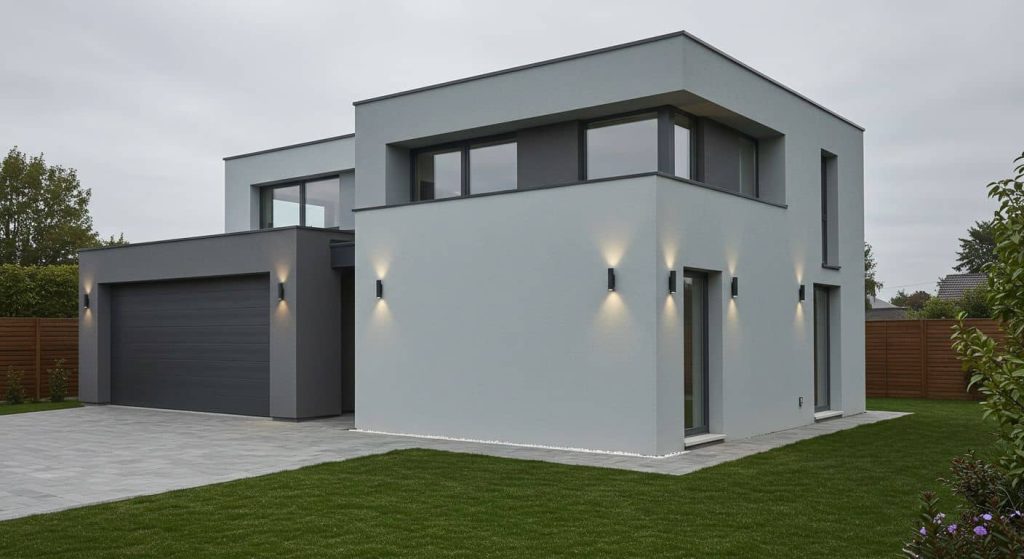
If you're ready to explore how energy-efficient EIFS colors can transform your home's appearance and performance, Indiana Wall Systems is here to help. With over 22 years of experience and more than 160 years of combined expertise on our team, we understand the unique challenges and opportunities of central Indiana's climate.
Our comprehensive approach includes:
- Detailed energy performance analysis of your current exterior
- Custom color recommendations based on your home's specific orientation, architecture, and microclimate
- Professional installation by our experienced, factory-trained crews
- Post-installation verification to confirm energy performance
Get Started with a Free Consultation
Contact us today to schedule your free consultation and discover how simple color choices can lead to significant energy savings.
Call (765) 341-6020 for your FREE estimate or visit our contact page to schedule an appointment.
Additional Resources and Color Inspiration
Looking for more information about energy-efficient EIFS options? Check out these helpful resources:
- The Ultimate Guide to EIFS Energy Efficiency
- Understanding the Value of EIFS Systems
- How EIFS Can Slash Your Energy Bills and Carbon Footprint
As we like to tell our clients at Indiana Wall Systems – when it comes to energy efficiency, what's on the outside of your walls matters just as much as what's inside them. By making informed color choices, you're not just creating a beautiful home – you're creating a more comfortable, efficient, and environmentally responsible living space that will serve you well for decades to come.
